James Cook University Anthropology Essay: Human-Animal Social Settings
VerifiedAdded on 2022/12/27
|8
|1779
|31
Essay
AI Summary
This essay delves into the multifaceted relationship between humans and animals from an anthropological perspective, examining the social meanings derived from these interactions. It explores diverse cultural contexts, including the Sundarbans region, and analyzes how different groups of people perceive and relate to animals like tigers. The essay draws upon various literary works and studies, highlighting the complex interplay between human and animal lives, and the influence of culture, religion, and environmental factors. The author emphasizes the importance of understanding these relationships for achieving a holistic environment, advocating for the protection of animals and the environment, and the role of cultural values in shaping human behavior and attitudes towards non-human species.
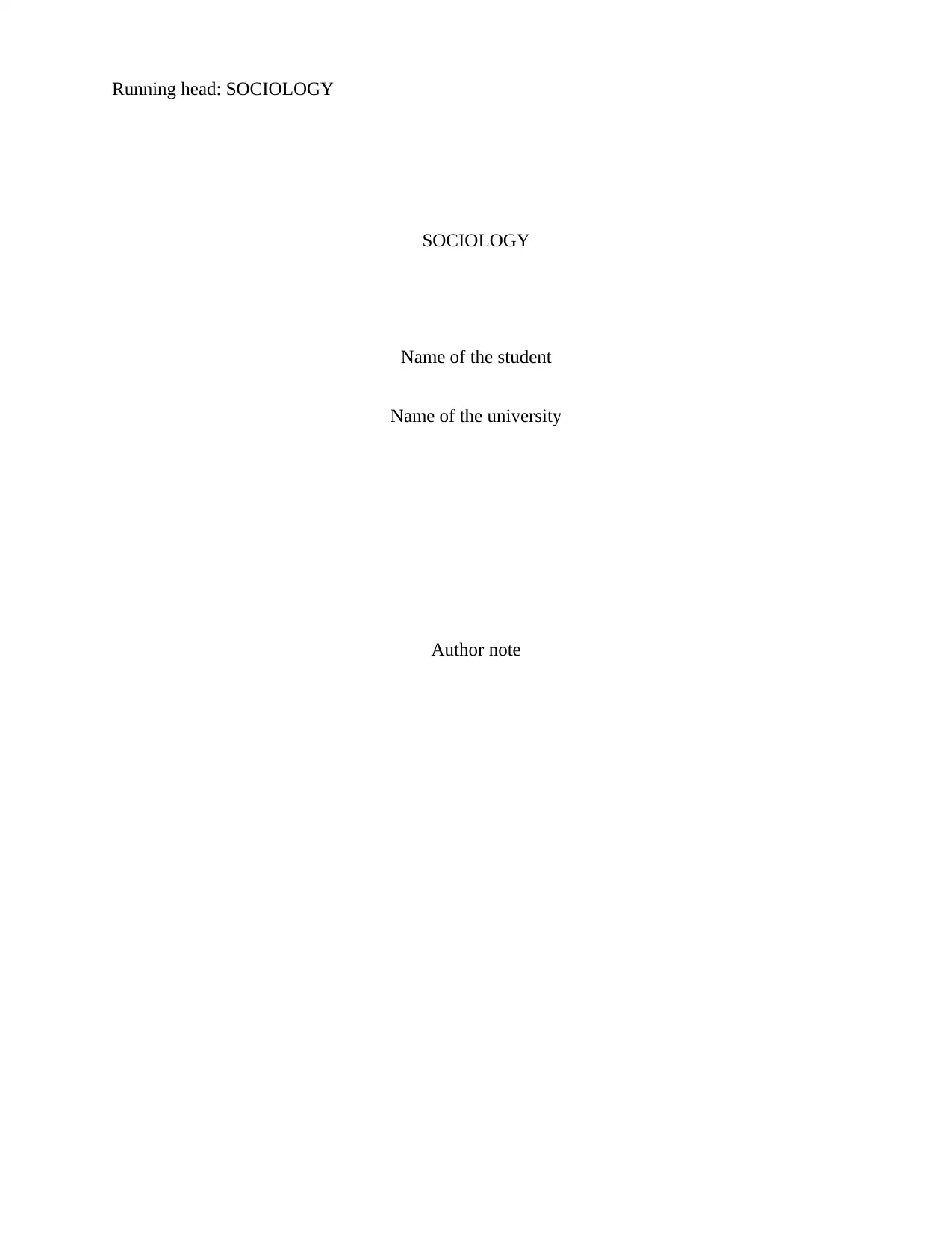
Running head: SOCIOLOGY
SOCIOLOGY
Name of the student
Name of the university
Author note
SOCIOLOGY
Name of the student
Name of the university
Author note
Paraphrase This Document
Need a fresh take? Get an instant paraphrase of this document with our AI Paraphraser
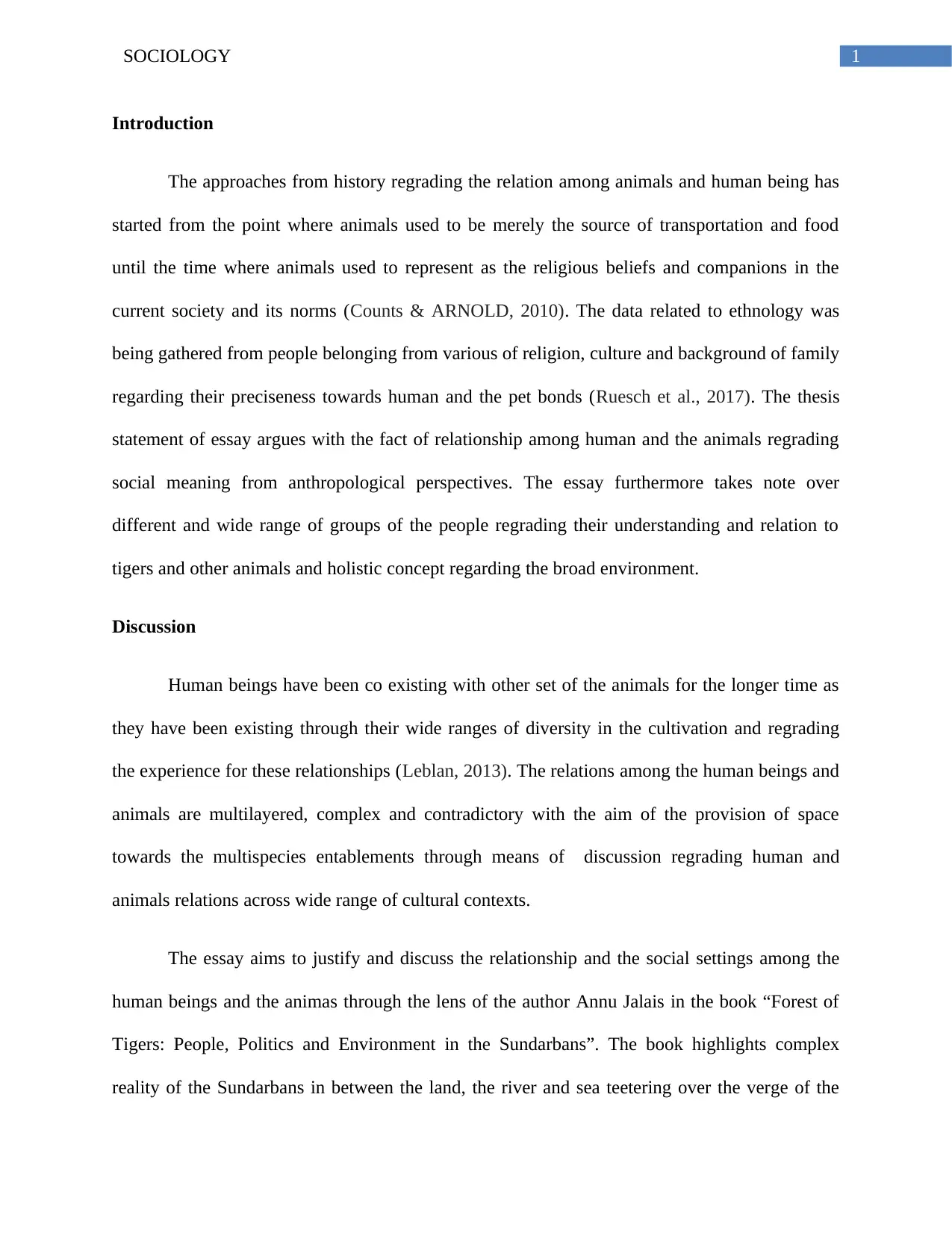
SOCIOLOGY 1
Introduction
The approaches from history regrading the relation among animals and human being has
started from the point where animals used to be merely the source of transportation and food
until the time where animals used to represent as the religious beliefs and companions in the
current society and its norms (Counts & ARNOLD, 2010). The data related to ethnology was
being gathered from people belonging from various of religion, culture and background of family
regarding their preciseness towards human and the pet bonds (Ruesch et al., 2017). The thesis
statement of essay argues with the fact of relationship among human and the animals regrading
social meaning from anthropological perspectives. The essay furthermore takes note over
different and wide range of groups of the people regrading their understanding and relation to
tigers and other animals and holistic concept regarding the broad environment.
Discussion
Human beings have been co existing with other set of the animals for the longer time as
they have been existing through their wide ranges of diversity in the cultivation and regrading
the experience for these relationships (Leblan, 2013). The relations among the human beings and
animals are multilayered, complex and contradictory with the aim of the provision of space
towards the multispecies entablements through means of discussion regrading human and
animals relations across wide range of cultural contexts.
The essay aims to justify and discuss the relationship and the social settings among the
human beings and the animas through the lens of the author Annu Jalais in the book “Forest of
Tigers: People, Politics and Environment in the Sundarbans”. The book highlights complex
reality of the Sundarbans in between the land, the river and sea teetering over the verge of the
Introduction
The approaches from history regrading the relation among animals and human being has
started from the point where animals used to be merely the source of transportation and food
until the time where animals used to represent as the religious beliefs and companions in the
current society and its norms (Counts & ARNOLD, 2010). The data related to ethnology was
being gathered from people belonging from various of religion, culture and background of family
regarding their preciseness towards human and the pet bonds (Ruesch et al., 2017). The thesis
statement of essay argues with the fact of relationship among human and the animals regrading
social meaning from anthropological perspectives. The essay furthermore takes note over
different and wide range of groups of the people regrading their understanding and relation to
tigers and other animals and holistic concept regarding the broad environment.
Discussion
Human beings have been co existing with other set of the animals for the longer time as
they have been existing through their wide ranges of diversity in the cultivation and regrading
the experience for these relationships (Leblan, 2013). The relations among the human beings and
animals are multilayered, complex and contradictory with the aim of the provision of space
towards the multispecies entablements through means of discussion regrading human and
animals relations across wide range of cultural contexts.
The essay aims to justify and discuss the relationship and the social settings among the
human beings and the animas through the lens of the author Annu Jalais in the book “Forest of
Tigers: People, Politics and Environment in the Sundarbans”. The book highlights complex
reality of the Sundarbans in between the land, the river and sea teetering over the verge of the
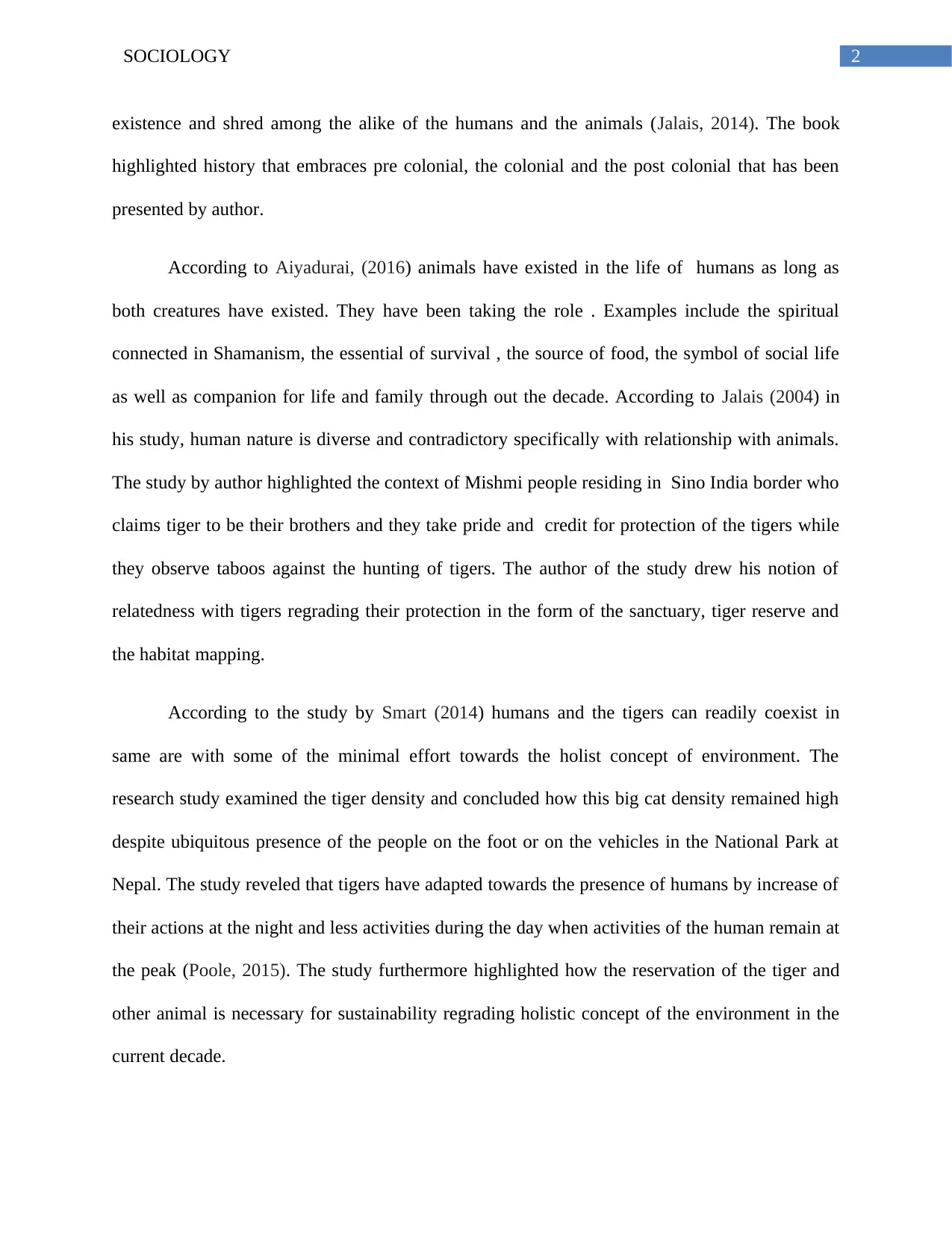
2SOCIOLOGY
existence and shred among the alike of the humans and the animals (Jalais, 2014). The book
highlighted history that embraces pre colonial, the colonial and the post colonial that has been
presented by author.
According to Aiyadurai, (2016) animals have existed in the life of humans as long as
both creatures have existed. They have been taking the role . Examples include the spiritual
connected in Shamanism, the essential of survival , the source of food, the symbol of social life
as well as companion for life and family through out the decade. According to Jalais (2004) in
his study, human nature is diverse and contradictory specifically with relationship with animals.
The study by author highlighted the context of Mishmi people residing in Sino India border who
claims tiger to be their brothers and they take pride and credit for protection of the tigers while
they observe taboos against the hunting of tigers. The author of the study drew his notion of
relatedness with tigers regrading their protection in the form of the sanctuary, tiger reserve and
the habitat mapping.
According to the study by Smart (2014) humans and the tigers can readily coexist in
same are with some of the minimal effort towards the holist concept of environment. The
research study examined the tiger density and concluded how this big cat density remained high
despite ubiquitous presence of the people on the foot or on the vehicles in the National Park at
Nepal. The study reveled that tigers have adapted towards the presence of humans by increase of
their actions at the night and less activities during the day when activities of the human remain at
the peak (Poole, 2015). The study furthermore highlighted how the reservation of the tiger and
other animal is necessary for sustainability regrading holistic concept of the environment in the
current decade.
existence and shred among the alike of the humans and the animals (Jalais, 2014). The book
highlighted history that embraces pre colonial, the colonial and the post colonial that has been
presented by author.
According to Aiyadurai, (2016) animals have existed in the life of humans as long as
both creatures have existed. They have been taking the role . Examples include the spiritual
connected in Shamanism, the essential of survival , the source of food, the symbol of social life
as well as companion for life and family through out the decade. According to Jalais (2004) in
his study, human nature is diverse and contradictory specifically with relationship with animals.
The study by author highlighted the context of Mishmi people residing in Sino India border who
claims tiger to be their brothers and they take pride and credit for protection of the tigers while
they observe taboos against the hunting of tigers. The author of the study drew his notion of
relatedness with tigers regrading their protection in the form of the sanctuary, tiger reserve and
the habitat mapping.
According to the study by Smart (2014) humans and the tigers can readily coexist in
same are with some of the minimal effort towards the holist concept of environment. The
research study examined the tiger density and concluded how this big cat density remained high
despite ubiquitous presence of the people on the foot or on the vehicles in the National Park at
Nepal. The study reveled that tigers have adapted towards the presence of humans by increase of
their actions at the night and less activities during the day when activities of the human remain at
the peak (Poole, 2015). The study furthermore highlighted how the reservation of the tiger and
other animal is necessary for sustainability regrading holistic concept of the environment in the
current decade.
⊘ This is a preview!⊘
Do you want full access?
Subscribe today to unlock all pages.

Trusted by 1+ million students worldwide
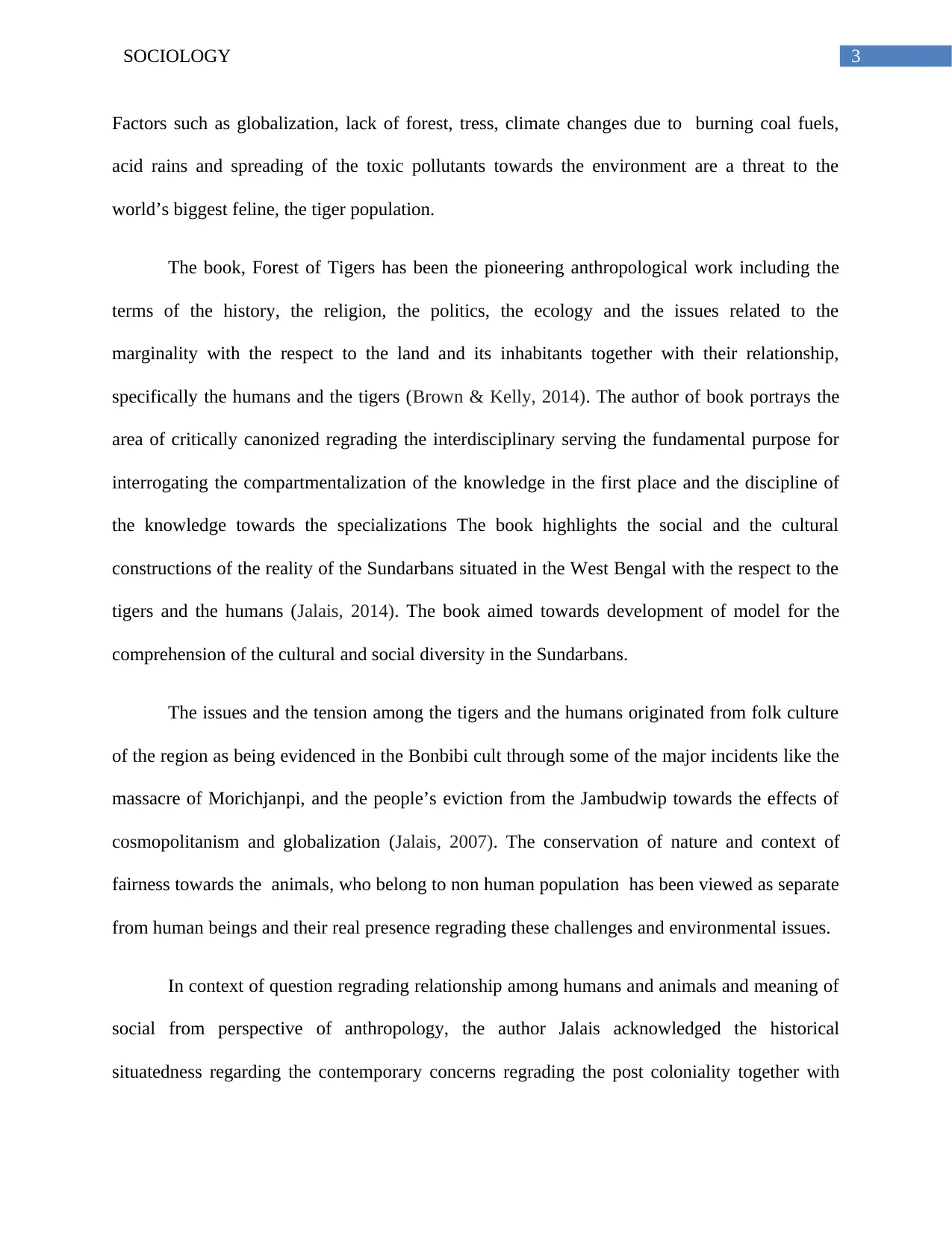
3SOCIOLOGY
Factors such as globalization, lack of forest, tress, climate changes due to burning coal fuels,
acid rains and spreading of the toxic pollutants towards the environment are a threat to the
world’s biggest feline, the tiger population.
The book, Forest of Tigers has been the pioneering anthropological work including the
terms of the history, the religion, the politics, the ecology and the issues related to the
marginality with the respect to the land and its inhabitants together with their relationship,
specifically the humans and the tigers (Brown & Kelly, 2014). The author of book portrays the
area of critically canonized regrading the interdisciplinary serving the fundamental purpose for
interrogating the compartmentalization of the knowledge in the first place and the discipline of
the knowledge towards the specializations The book highlights the social and the cultural
constructions of the reality of the Sundarbans situated in the West Bengal with the respect to the
tigers and the humans (Jalais, 2014). The book aimed towards development of model for the
comprehension of the cultural and social diversity in the Sundarbans.
The issues and the tension among the tigers and the humans originated from folk culture
of the region as being evidenced in the Bonbibi cult through some of the major incidents like the
massacre of Morichjanpi, and the people’s eviction from the Jambudwip towards the effects of
cosmopolitanism and globalization (Jalais, 2007). The conservation of nature and context of
fairness towards the animals, who belong to non human population has been viewed as separate
from human beings and their real presence regrading these challenges and environmental issues.
In context of question regrading relationship among humans and animals and meaning of
social from perspective of anthropology, the author Jalais acknowledged the historical
situatedness regarding the contemporary concerns regrading the post coloniality together with
Factors such as globalization, lack of forest, tress, climate changes due to burning coal fuels,
acid rains and spreading of the toxic pollutants towards the environment are a threat to the
world’s biggest feline, the tiger population.
The book, Forest of Tigers has been the pioneering anthropological work including the
terms of the history, the religion, the politics, the ecology and the issues related to the
marginality with the respect to the land and its inhabitants together with their relationship,
specifically the humans and the tigers (Brown & Kelly, 2014). The author of book portrays the
area of critically canonized regrading the interdisciplinary serving the fundamental purpose for
interrogating the compartmentalization of the knowledge in the first place and the discipline of
the knowledge towards the specializations The book highlights the social and the cultural
constructions of the reality of the Sundarbans situated in the West Bengal with the respect to the
tigers and the humans (Jalais, 2014). The book aimed towards development of model for the
comprehension of the cultural and social diversity in the Sundarbans.
The issues and the tension among the tigers and the humans originated from folk culture
of the region as being evidenced in the Bonbibi cult through some of the major incidents like the
massacre of Morichjanpi, and the people’s eviction from the Jambudwip towards the effects of
cosmopolitanism and globalization (Jalais, 2007). The conservation of nature and context of
fairness towards the animals, who belong to non human population has been viewed as separate
from human beings and their real presence regrading these challenges and environmental issues.
In context of question regrading relationship among humans and animals and meaning of
social from perspective of anthropology, the author Jalais acknowledged the historical
situatedness regarding the contemporary concerns regrading the post coloniality together with
Paraphrase This Document
Need a fresh take? Get an instant paraphrase of this document with our AI Paraphraser
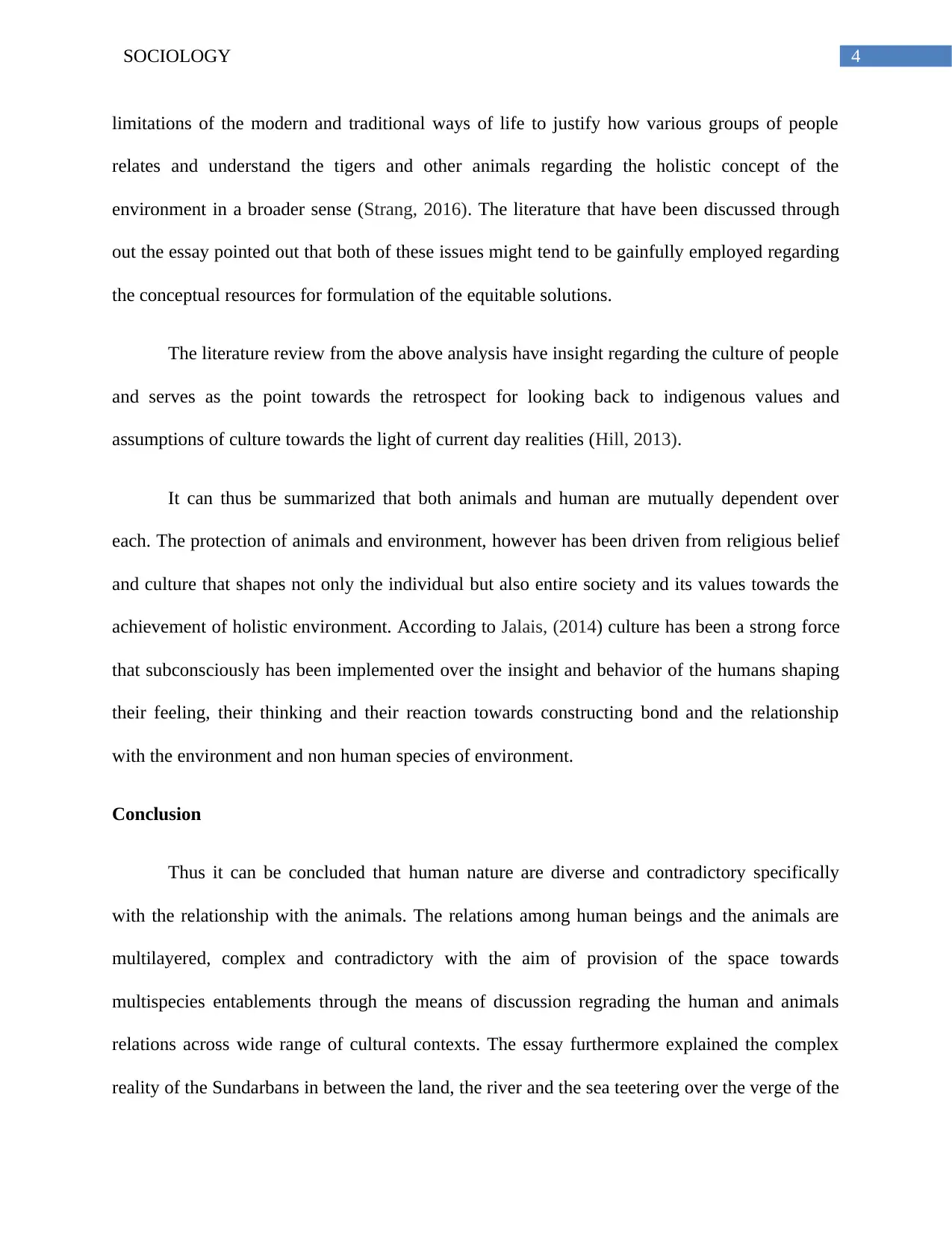
4SOCIOLOGY
limitations of the modern and traditional ways of life to justify how various groups of people
relates and understand the tigers and other animals regarding the holistic concept of the
environment in a broader sense (Strang, 2016). The literature that have been discussed through
out the essay pointed out that both of these issues might tend to be gainfully employed regarding
the conceptual resources for formulation of the equitable solutions.
The literature review from the above analysis have insight regarding the culture of people
and serves as the point towards the retrospect for looking back to indigenous values and
assumptions of culture towards the light of current day realities (Hill, 2013).
It can thus be summarized that both animals and human are mutually dependent over
each. The protection of animals and environment, however has been driven from religious belief
and culture that shapes not only the individual but also entire society and its values towards the
achievement of holistic environment. According to Jalais, (2014) culture has been a strong force
that subconsciously has been implemented over the insight and behavior of the humans shaping
their feeling, their thinking and their reaction towards constructing bond and the relationship
with the environment and non human species of environment.
Conclusion
Thus it can be concluded that human nature are diverse and contradictory specifically
with the relationship with the animals. The relations among human beings and the animals are
multilayered, complex and contradictory with the aim of provision of the space towards
multispecies entablements through the means of discussion regrading the human and animals
relations across wide range of cultural contexts. The essay furthermore explained the complex
reality of the Sundarbans in between the land, the river and the sea teetering over the verge of the
limitations of the modern and traditional ways of life to justify how various groups of people
relates and understand the tigers and other animals regarding the holistic concept of the
environment in a broader sense (Strang, 2016). The literature that have been discussed through
out the essay pointed out that both of these issues might tend to be gainfully employed regarding
the conceptual resources for formulation of the equitable solutions.
The literature review from the above analysis have insight regarding the culture of people
and serves as the point towards the retrospect for looking back to indigenous values and
assumptions of culture towards the light of current day realities (Hill, 2013).
It can thus be summarized that both animals and human are mutually dependent over
each. The protection of animals and environment, however has been driven from religious belief
and culture that shapes not only the individual but also entire society and its values towards the
achievement of holistic environment. According to Jalais, (2014) culture has been a strong force
that subconsciously has been implemented over the insight and behavior of the humans shaping
their feeling, their thinking and their reaction towards constructing bond and the relationship
with the environment and non human species of environment.
Conclusion
Thus it can be concluded that human nature are diverse and contradictory specifically
with the relationship with the animals. The relations among human beings and the animals are
multilayered, complex and contradictory with the aim of provision of the space towards
multispecies entablements through the means of discussion regrading the human and animals
relations across wide range of cultural contexts. The essay furthermore explained the complex
reality of the Sundarbans in between the land, the river and the sea teetering over the verge of the
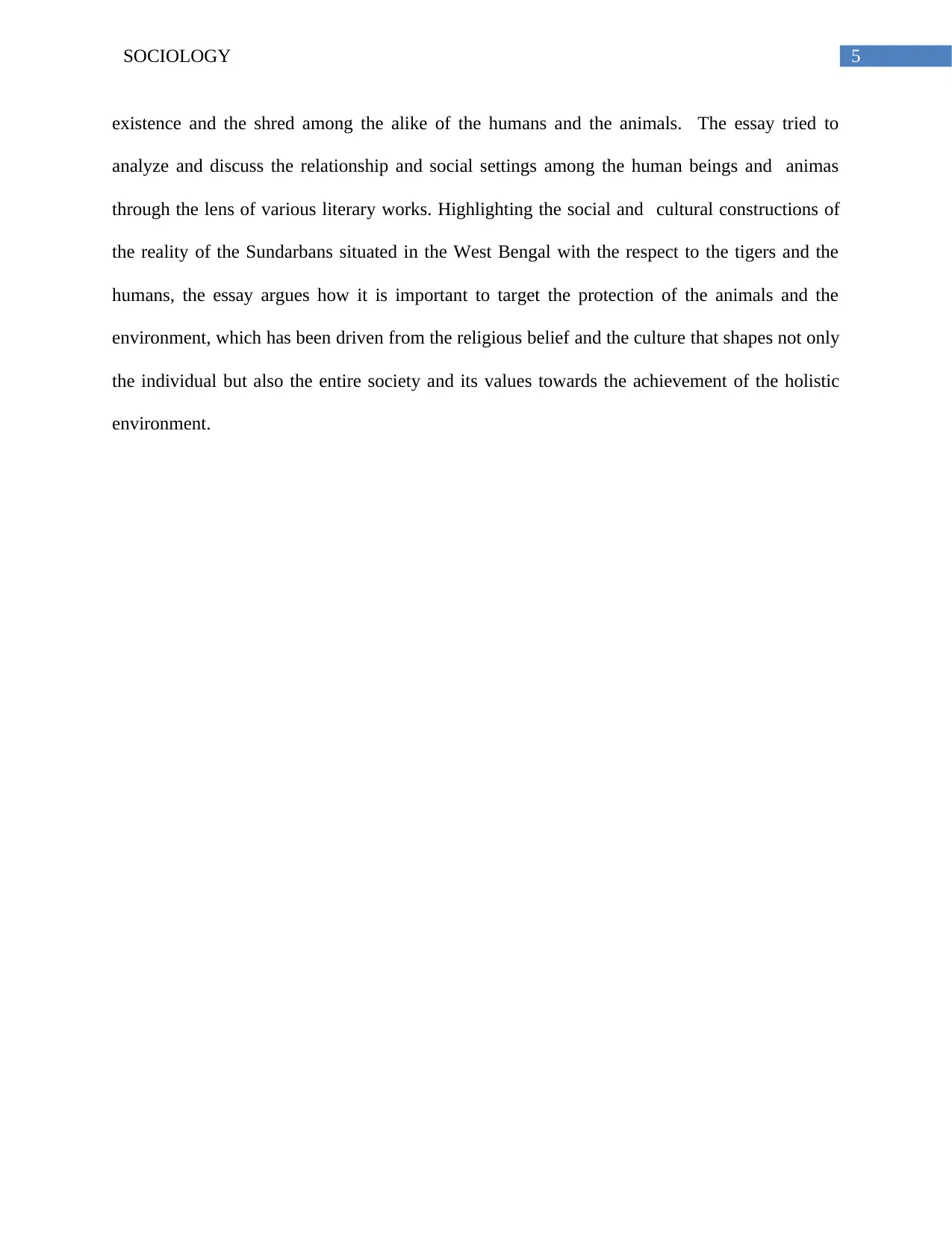
5SOCIOLOGY
existence and the shred among the alike of the humans and the animals. The essay tried to
analyze and discuss the relationship and social settings among the human beings and animas
through the lens of various literary works. Highlighting the social and cultural constructions of
the reality of the Sundarbans situated in the West Bengal with the respect to the tigers and the
humans, the essay argues how it is important to target the protection of the animals and the
environment, which has been driven from the religious belief and the culture that shapes not only
the individual but also the entire society and its values towards the achievement of the holistic
environment.
existence and the shred among the alike of the humans and the animals. The essay tried to
analyze and discuss the relationship and social settings among the human beings and animas
through the lens of various literary works. Highlighting the social and cultural constructions of
the reality of the Sundarbans situated in the West Bengal with the respect to the tigers and the
humans, the essay argues how it is important to target the protection of the animals and the
environment, which has been driven from the religious belief and the culture that shapes not only
the individual but also the entire society and its values towards the achievement of the holistic
environment.
⊘ This is a preview!⊘
Do you want full access?
Subscribe today to unlock all pages.

Trusted by 1+ million students worldwide
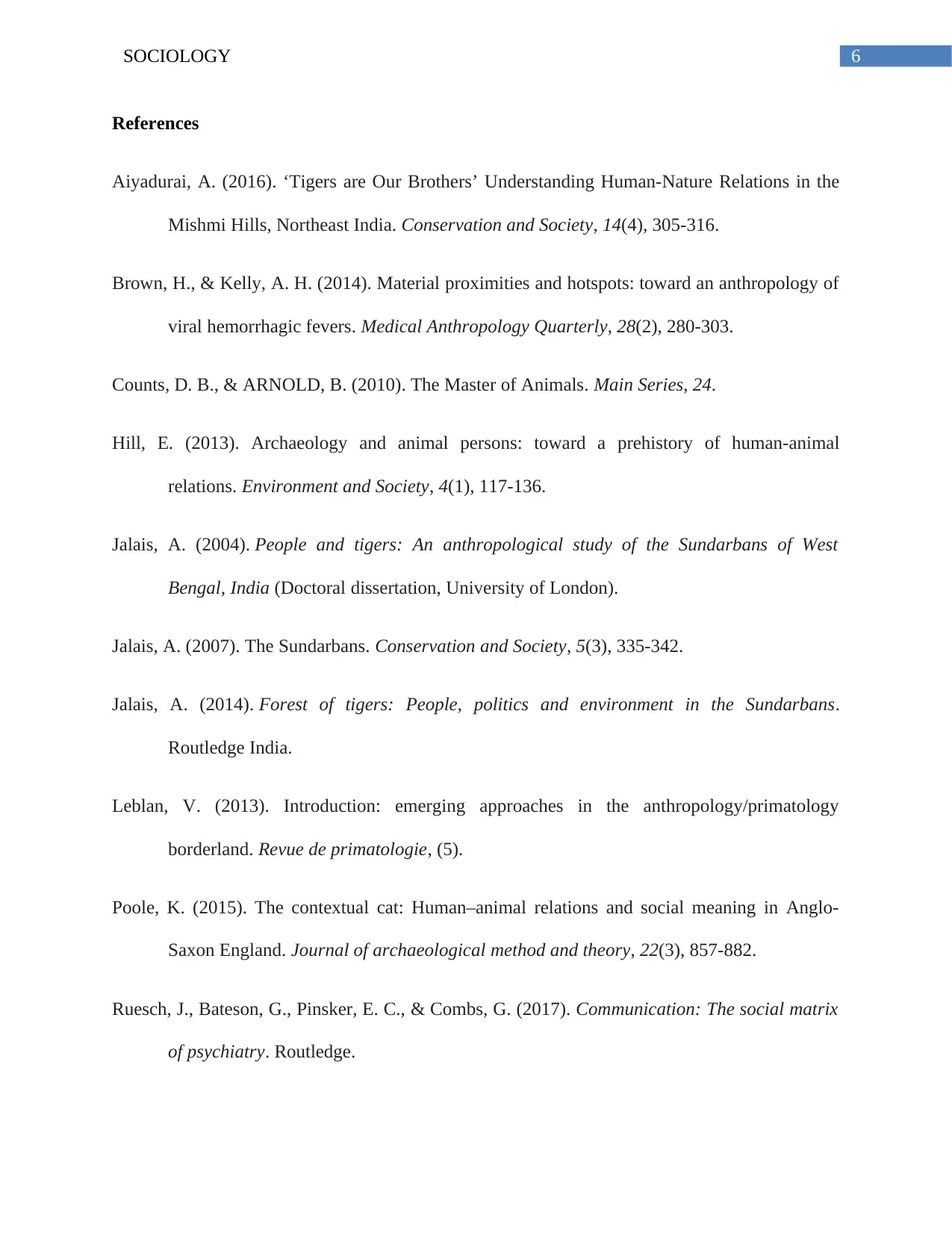
6SOCIOLOGY
References
Aiyadurai, A. (2016). ‘Tigers are Our Brothers’ Understanding Human-Nature Relations in the
Mishmi Hills, Northeast India. Conservation and Society, 14(4), 305-316.
Brown, H., & Kelly, A. H. (2014). Material proximities and hotspots: toward an anthropology of
viral hemorrhagic fevers. Medical Anthropology Quarterly, 28(2), 280-303.
Counts, D. B., & ARNOLD, B. (2010). The Master of Animals. Main Series, 24.
Hill, E. (2013). Archaeology and animal persons: toward a prehistory of human-animal
relations. Environment and Society, 4(1), 117-136.
Jalais, A. (2004). People and tigers: An anthropological study of the Sundarbans of West
Bengal, India (Doctoral dissertation, University of London).
Jalais, A. (2007). The Sundarbans. Conservation and Society, 5(3), 335-342.
Jalais, A. (2014). Forest of tigers: People, politics and environment in the Sundarbans.
Routledge India.
Leblan, V. (2013). Introduction: emerging approaches in the anthropology/primatology
borderland. Revue de primatologie, (5).
Poole, K. (2015). The contextual cat: Human–animal relations and social meaning in Anglo-
Saxon England. Journal of archaeological method and theory, 22(3), 857-882.
Ruesch, J., Bateson, G., Pinsker, E. C., & Combs, G. (2017). Communication: The social matrix
of psychiatry. Routledge.
References
Aiyadurai, A. (2016). ‘Tigers are Our Brothers’ Understanding Human-Nature Relations in the
Mishmi Hills, Northeast India. Conservation and Society, 14(4), 305-316.
Brown, H., & Kelly, A. H. (2014). Material proximities and hotspots: toward an anthropology of
viral hemorrhagic fevers. Medical Anthropology Quarterly, 28(2), 280-303.
Counts, D. B., & ARNOLD, B. (2010). The Master of Animals. Main Series, 24.
Hill, E. (2013). Archaeology and animal persons: toward a prehistory of human-animal
relations. Environment and Society, 4(1), 117-136.
Jalais, A. (2004). People and tigers: An anthropological study of the Sundarbans of West
Bengal, India (Doctoral dissertation, University of London).
Jalais, A. (2007). The Sundarbans. Conservation and Society, 5(3), 335-342.
Jalais, A. (2014). Forest of tigers: People, politics and environment in the Sundarbans.
Routledge India.
Leblan, V. (2013). Introduction: emerging approaches in the anthropology/primatology
borderland. Revue de primatologie, (5).
Poole, K. (2015). The contextual cat: Human–animal relations and social meaning in Anglo-
Saxon England. Journal of archaeological method and theory, 22(3), 857-882.
Ruesch, J., Bateson, G., Pinsker, E. C., & Combs, G. (2017). Communication: The social matrix
of psychiatry. Routledge.
Paraphrase This Document
Need a fresh take? Get an instant paraphrase of this document with our AI Paraphraser
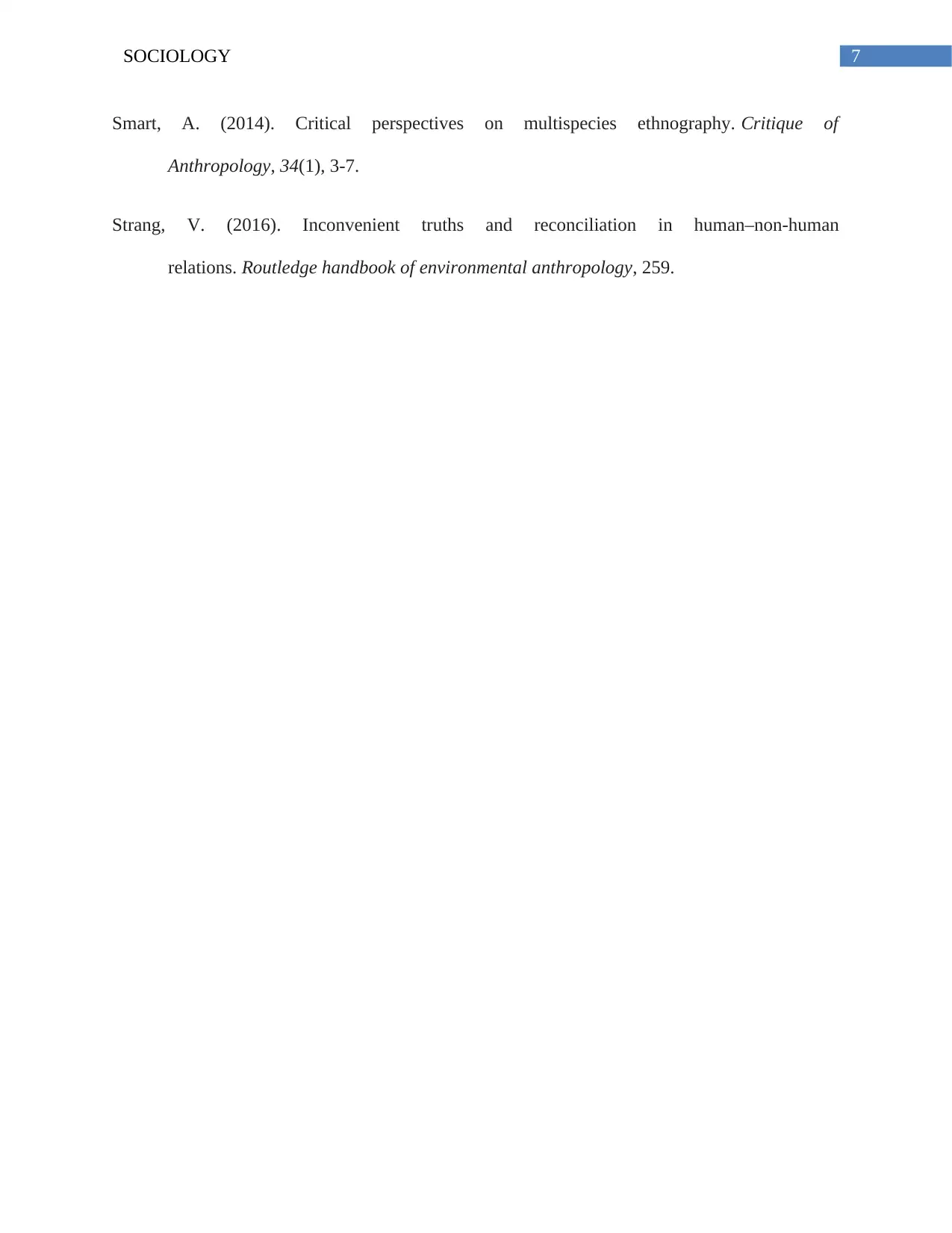
7SOCIOLOGY
Smart, A. (2014). Critical perspectives on multispecies ethnography. Critique of
Anthropology, 34(1), 3-7.
Strang, V. (2016). Inconvenient truths and reconciliation in human–non-human
relations. Routledge handbook of environmental anthropology, 259.
Smart, A. (2014). Critical perspectives on multispecies ethnography. Critique of
Anthropology, 34(1), 3-7.
Strang, V. (2016). Inconvenient truths and reconciliation in human–non-human
relations. Routledge handbook of environmental anthropology, 259.
1 out of 8
Related Documents
Your All-in-One AI-Powered Toolkit for Academic Success.
+13062052269
info@desklib.com
Available 24*7 on WhatsApp / Email
![[object Object]](/_next/static/media/star-bottom.7253800d.svg)
Unlock your academic potential
Copyright © 2020–2025 A2Z Services. All Rights Reserved. Developed and managed by ZUCOL.





